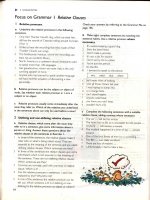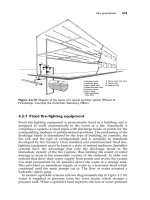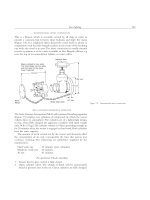Astm e 1860 13
Bạn đang xem bản rút gọn của tài liệu. Xem và tải ngay bản đầy đủ của tài liệu tại đây (81.82 KB, 3 trang )
Designation: E1860 − 13
Standard Test Method for
Elapsed Time Calibration of Thermal Analyzers1
This standard is issued under the fixed designation E1860; the number immediately following the designation indicates the year of
original adoption or, in the case of revision, the year of last revision. A number in parentheses indicates the year of last reapproval. A
superscript epsilon (´) indicates an editorial change since the last revision or reapproval.
E1858 Test Method for Determining Oxidation Induction
Time of Hydrocarbons by Differential Scanning Calorimetry
E1868 Test Method for Loss-On-Drying by Thermogravimetry
E2161 Terminology Relating to Performance Validation in
Thermal Analysis
1. Scope
1.1 This test method describes the calibration or performance confirmation of the elapsed-time signal from thermal
analyzers.
1.2 The values stated in SI units are to be regarded as
standard. No other units of measurement are included in this
standard.
3. Terminology
1.3 There is no ISO standard equivalent to this test method.
1.4 This standard does not purport to address all of the
safety concerns, if any, associated with its use. It is the
responsibility of the user of this standard to establish appropriate safety and health practices and determine the applicability of regulatory limitations prior to use.
3.1 Definitions:
3.1.1 The technical terms used in this test method are
defined in Terminologies E473, E1142, and E2161, including
calibration, conformance, relative standard deviation, and thermal analysis.
4. Summary of Test Method
2. Referenced Documents
4.1 The elapsed time signal generated by a thermal analyzer
is compared to a clock (or timer) whose performance is known
and traceable to a national metrology institute. The thermal
analyzer may be said to be in conformance, if the performance
of the thermal analyzer is within established limits.
Alternatively, the elapsed time signal may be calibrated using
a two point calibration method.
2.1 ASTM Standards:2
D3350 Specification for Polyethylene Plastics Pipe and Fittings Materials
D3895 Test Method for Oxidative-Induction Time of Polyolefins by Differential Scanning Calorimetry
D4565 Test Methods for Physical and Environmental Performance Properties of Insulations and Jackets for Telecommunications Wire and Cable
D5483 Test Method for Oxidation Induction Time of Lubricating Greases by Pressure Differential Scanning Calorimetry
E473 Terminology Relating to Thermal Analysis and Rheology
E487 Test Method for Constant-Temperature Stability of
Chemical Materials
E691 Practice for Conducting an Interlaboratory Study to
Determine the Precision of a Test Method
E1142 Terminology Relating to Thermophysical Properties
5. Significance and Use
5.1 Most thermal analysis experiments are carried out under
increasing temperature conditions where temperature is the
independent parameter. Some experiments, however, are carried out under isothermal temperature conditions where the
elapsed time to an event is measured as the independent
parameter. Isothermal Kinetics (Test Methods E2070), Thermal
Stability (Test Method E487), Oxidative Induction Time (OIT)
(Test Methods D3895, D4565, D5483, E1858, and Specification D3350 and Loss-on-Drying (Test Method E1868) are
common examples of these kinds of experiments.
5.2 Modern scientific instruments, including thermal
analyzers, usually measure elapsed time with excellent precision and accuracy. In such cases, it may only be necessary to
confirm the performance of the instrument by comparison to a
suitable reference. Only rarely will it may be required to
correct the calibration of an instrument’s elapsed time signal
through the use of a calibration factor.
1
This test method is under the jurisdiction of ASTM Committee E37 on Thermal
Measurements and is the direct responsibility of Subcommittee E37.10 on
Fundamental, Statistical and Mechanical Properties.
Current edition approved Sept. 15, 2013. Published September 2013. Originally
approved in 1997. Last previous edition approved in 2007 as E1860 – 07. DOI:
10.1520/E1860-13.
2
For referenced ASTM standards, visit the ASTM website, www.astm.org, or
contact ASTM Customer Service at For Annual Book of ASTM
Standards volume information, refer to the standard’s Document Summary page on
the ASTM website.
5.3 It is necessary to obtain elapsed time signal conformity
only to 0.1 times the repeatability relative standard deviation
Copyright © ASTM International, 100 Barr Harbor Drive, PO Box C700, West Conshohocken, PA 19428-2959. United States
1
E1860 − 13
(standard deviation divided by the mean value) expressed as a
percent for the test method in which the thermal analyzer is to
be used. For those test methods listed in Section 2 this
conformity is 0.1 %.
t 5 t oS
(1)
where:
t = true experimental elapsed time (s),
to = thermal analyzer observed elapsed time (s), and
S = slope (nominal value = 1.00000).
6. Apparatus
9.2 Using the values for t1 and t2 from 8.1, the instrument
reaction time (I) may be calculated by:
6.1 Timer or Stopwatch, with timing capacity of at least 3 h
(10 800 s), a resolution of 0.1 s or better and an accuracy of 1.5
s per day which performance has been verified using standards
and procedures traceable to a national metrology institute (such
as the National Institute of Standards and Technology (NIST)).
Such timers are available from most laboratory equipment
suppliers.
I 5 t1 2 t2
(2)
9.3 Using the values for tt and to from 8.2, the calibration
constant S may be calculated by:
S 5 ~ t t 2 I ! /t o
(3)
7. Calibration
where:
tt = observed time of reference timer.
7.1 Perform any elapsed time signal calibration procedures
recommended by the manufacturer of the thermal analyzer as
described in the Operator’s Manual.
9.3.1 When performing this calculation, retain all available
decimal places in the measured value and in the value of S.
9.4 Using the value for S from 9.3, the percent conformity
of the instrument elapsed time indicator may be calculated as
follows:
8. Procedure
8.1 Obtain the instrument reaction time (I).
8.1.1 Reset the timer and the elapsed time signal for the
thermal analyzer to zero elapsed time.
8.1.2 Simultaneously start the timer and the elapsed time
signal for the thermal analyzer. Allow them to run for 6 to 10
s. Simultaneously stop the timer and the elapsed time signal for
the thermal analyzer. Record the elapsed time from the timer as
t1. Record the elapsed time from the thermal analyzer as t2.
C 5 ~ 1.00000 2 S ! 3 100 %
(4)
NOTE 4—The percent conformity is usually a very small number and
expressing it as a percent value may be inconsistent with SI metric
notation. Because of its effect on the experiment and because of common
use, it is expressed as a percent is this procedure.
9.4.1 Conformity may be estimated to one significant figure
using the following criteria:
9.4.1.1 If S lies:
NOTE 1—The elapsed time of the timer (t1) is equal to the elapsed time
of the thermal analyzer (t 2) plus the instrument reaction time (I). The
instrument reaction time is that required for the thermal analyzer to
initialize and terminate the thermal analysis experiment and may be up to
several seconds. The instrument start up time does not affect the elapsed
time of the thermal analysis experiment since the experiment is exclusive
of this time.
NOTE 2—Data acquisition rate shall be set to the maximum available.
NOTE 3—Time measurements shall be recorded in seconds retaining all
available digits.
Between 0.9999 and 1.0001, then conformity is better than 0.01 %,
Between 0.9990 and 0.9999 or between 1.0001 and 1.0010, then conformity is
better than 0.1 %, and
Between 0.9900 and 0.9990 or between 1.0010 and 1.0100, then conformity is
better than 1 %.
9.5 Using the determined value for S, Eq 1 may be used to
calculate the true elapsed time (t) from an observed elapsed
time (to).
10. Report
8.1.3 Calculate the instrument reaction time I by Eq 2 (9.2).
10.1 Report the following information:
10.1.1 Model number and description of the Thermal Analyzer used,
10.1.2 The value of S as determined in 8.2.3 reported to at
least five places to the right of the decimal point, and
10.1.3 Conformity as determined in 9.4.
8.2 Obtain the calibration constant (S).
8.2.1 Reset the timer and the elapsed time signal for the
thermal analyzer to zero elapsed time.
8.2.2 Simultaneously start the timer and the elapsed time
signal for the thermal analyzer. Allow them to run for a
minimum of 10 000 s ( = 167 min = 2.8 h = 2 h, 47 min).
Simultaneously stop the timer and the elapsed time signal for
the thermal analyzer (see Note 2, Note 3, and Note 4). Record
the elapsed time from the timer as tt. Record the elapsed time
from the thermal analyzer as to.
8.2.3 Calculate the value for S using Eq 3 (see 9.3).
11. Precision and Bias
11.1 An interlaboratory study of elapsed time calibration
was conducted in 1996 that included participation by nine
laboratories using instruments from four manufacturers. The
results were treated by Practice E691.3
8.3 Using the values for I and S from 8.1.3 and 8.2.3,
calculate the percent conformity (C) using Eq 4 or table of
percent conformity values (see 9.4).
11.2 Precision:
11.2.1 The mean value for the calibration constant was
S = 0.999853.
9. Calculation
9.1 For the purpose of these procedures, it is assumed that
the relationship between observed elapsed time (to) and the
actual elapsed time (t) is linear and is governed by Eq 1:
3
Supporting data have been filed at ASTM International Headquarters and may
be obtained by requesting Research Report RR:E37-1019. Contact ASTM Customer
Service at
2
E1860 − 13
11.2.2 The repeatability (within laboratory) standard deviation for S was 0.000034.
11.2.2.1 Two values, each the mean of duplicate determinations within a single laboratory should be considered suspect if
they differ by more than the 95 % repeatability limit r
= 0.000095.
11.2.3 The reproducibility (between laboratory) standard
deviation for S was 0.00024.
11.2.3.1 Two values, each the mean of duplicate determinations in differing laboratories, should be considered suspect, if
they differ by more than the 95 % reproducibility limit
R = 0.00069.
11.3 Bias:
11.3.1 The measurement of conformity in this test method is
a comparison of the calibration constant S with the theoretical
value of 1.000000 and provides an indication of bias.
11.3.2 The mean value for conformity was C = 0.015 %.
11.3.3 Conformity was found to vary widely among instrument models but in no case exceeded C = 0.05 %. This value is
far better than the nominal conformity of 1 % required for most
thermal analysis experiments.
12. Keywords
12.1 calibration; elapsed time; thermal analysis; time
ASTM International takes no position respecting the validity of any patent rights asserted in connection with any item mentioned
in this standard. Users of this standard are expressly advised that determination of the validity of any such patent rights, and the risk
of infringement of such rights, are entirely their own responsibility.
This standard is subject to revision at any time by the responsible technical committee and must be reviewed every five years and
if not revised, either reapproved or withdrawn. Your comments are invited either for revision of this standard or for additional standards
and should be addressed to ASTM International Headquarters. Your comments will receive careful consideration at a meeting of the
responsible technical committee, which you may attend. If you feel that your comments have not received a fair hearing you should
make your views known to the ASTM Committee on Standards, at the address shown below.
This standard is copyrighted by ASTM International, 100 Barr Harbor Drive, PO Box C700, West Conshohocken, PA 19428-2959,
United States. Individual reprints (single or multiple copies) of this standard may be obtained by contacting ASTM at the above
address or at 610-832-9585 (phone), 610-832-9555 (fax), or (e-mail); or through the ASTM website
(www.astm.org). Permission rights to photocopy the standard may also be secured from the ASTM website (www.astm.org/
COPYRIGHT/).
3









